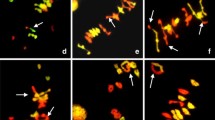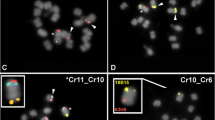Abstract
An E-type bridge is formed at AI of meiosis by a proximal connection between the long arm of an acrooentric chromosome and the short arm of its homologue. A long acentric fragment is also produced, consisting of an erstwhile long and short arm. Heteromorphy of homologues indicates that the bridge is formed as a result of crossing over in a non-inverted segment of chromosome translocated from one arm to the other by successive paracentric and pericentric inversions. There is no evidence that translocated centromere regions pair. E-type bridges occur in the Aloineae (Liliaceae) in 20 out of 163 taxa studied. It is suggested that a high incidence of E-type bridges is indicative of inter-specific hybridity.
Similar content being viewed by others
References
Brandham, P. E.: Inversion heterozygosity and sub-chromatid exchange in Agave stricta. Chromosoma (Berl.) 26, 270–286 (1969).
Darlington, C. D.: Misdivision and the genetics of the centromere. J. Genet. 37, 341–364 (1939).
— Cytology. London: J. & A. Churchill 1965.
—, and M. Keffallinou: Correlated chromosome aberrations at meiosis in Gasteria. Chromosoma (Berl.) 8, 364–370 (1957).
Jacobsen, H.: A handbook of succulent plants, vol. 2. London: Blandford Press 1960.
Reynolds, G. W.: The aloes of South Africa. Johannesburg: The aloes of South Africa book fund 1950.
—: The aloes of tropical Africa and Madagascar. Mbabane, Swaziland: The aloes book fund 1966.
Ribbands, C. R.: The consequences of structural hybridity at meiosis in Lilium X testaceum. J. Genet. 35, 1–24 (1937).
Riley, H. P., and S. K. Majumdar: Three new chromosomal translocations in Haworthia. Can. J. Genet. Cytol. 10, 487–494 (1968).
—, and D. Mukerjee: Two aneuploid plants of Haworthia. J. Hered. 53, 105–109 (1962).
— Some new chromosome studies in the Coarctatae and other sections of Haworthia. Nucleus 8, 149–156 (1965).
Sato, D.: Karyotype alteration and phylogeny in Liliaceae and allied families. Jap. J. Bot. 12, 132–161 (1942).
Author information
Authors and Affiliations
Rights and permissions
About this article
Cite this article
Brandham, P.E. Chromosome behaviour in the Aloineae . Chromosoma 27, 201–215 (1969). https://doi.org/10.1007/BF00326145
Received:
Accepted:
Issue Date:
DOI: https://doi.org/10.1007/BF00326145




